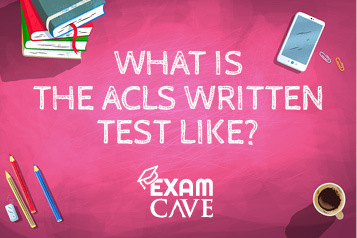What Is the ACLS Written Test Like?

If you plan to become a doctor, you should expect to take many different tests. For instance, the MCAT is what you take to get into medical school after finishing your undergraduate studies. The USMLE is a series of exams administered during and after medical school, ultimately determining whether you get your license to practice.
However, there are other tests you need to take, too, even once you’re licensed. The Advanced Cardiac Life Support (ACLS) exam is one such test. It’s different from entrance and aptitude exams because it’s neither one of those. Instead, it’s a certification exam.
Doctors, nurses, EMTs, paramedics, firefighters, and anyone else who may have to handle a medical emergency in the course of their work needs to pass this test to earn and retain certification.
Table of Contents
What is the ACLS Test?
Advanced Cardiac Life Support is a crucial aspect of emergency medical care. Most healthcare practitioners must have ACLS certification because emergency care is such an essential part of healthcare. Countless healthcare providers and emergency service providers take this test each year to earn and maintain their certifications.
The ACLS exam has two parts: Practical scenarios and a written portion. The scenario portion covers several common emergency situations you’ll encounter during your career. It takes into account advances in science and technology and reflects that each time you take the test.
The Written Portion of the ACLS Test
The written portion of the exam deals with algorithms. You might associate algorithms with computing and the Internet, but these algorithms are completely different. They are:
- Acute Coronary Syndromes Algorithm
- Adult BLS Algorithm
- Adult Bradycardia Algorithm
- Adult Cardiac Arrest Algorithm
- Adult Suspected Stroke Algorithm
- Adult Tachycardia Algorithm
- Immediate Post-Cardiac Arrest Care Algorithm
- Opioid-Associated Life-Threatening Emergency Algorithm
- Unstable Tachycardia Algorithm
Unlike many other written tests, where you should be fine just knowing and understanding various facts and concepts, your best bet for passing the ACLS test’s written part is to memorize each algorithm.
That means finding the best memorization tools for yourself. Everyone memorizes things differently. Some do well with simple repetition, some use things like mnemonic devices or other tricks, and some have other ideas. How you memorize the algorithms before you take the test is up to you.
What to Expect When You Go to Take It
It’s a short but difficult test because of all the things you need to memorize. You can expect 50 multiple choice questions covering all nine algorithms. It takes about one hour to complete, and you need a score of at least 85 percent to pass.
The written test, while challenging, isn’t as hard or as long as the scenario-based portion, and the fact that it’s a multiple-choice test makes it easier. But the fact that you need to get at least 43 of those questions correct can put a lot of pressure on you.
If you’re worried about that, you can find manys sample test and prep books online that will help you. They tend to have ten to 15 multiple-choice questions similar to what you’d find on the written part of the ACLS test, along with the correct answers at the bottom. Use those to prepare, especially for your first time taking it.
Finally, this is a stressful test. When you go to take the written portion, you should expect to feel nervous. Don’t rush through it, though. As most of us learned at some point, rushing through a test is an excellent way to fail it.
Final Thoughts
If you’re taking the ACLS exam, you’ve already got some type of medical training and certification. This test is for EMTs, firefighters, nurses, doctors, paramedics, and anyone who might have to face an emergency medical situation. Without this certification, you may find yourself barred from performing any emergency care, which will hinder your career.
The written part of the test might sound like it’s easy, and it’s short – just 50 multiple-choice questions. However, it’s not as easy as it sounds because you need to have all your algorithms memorized before taking it. You also have to achieve a fairly high score just to pass this section.
If you prepare for it each time you need to take it, though, then you’re better equipped to pass it along with the scenario-based portion of the exam, and thus, earn and maintain your certification.
